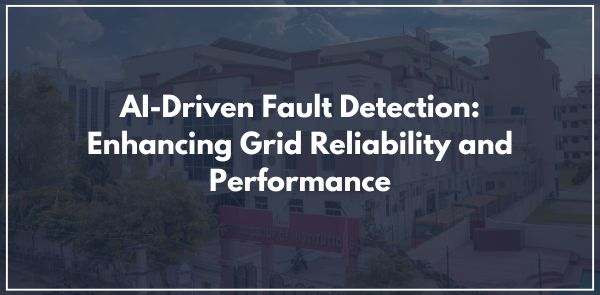The increasing complexity and interconnectedness of modern power grids, driven by the integration of renewable energy sources and distributed generation, pose significant challenges to grid reliability and performance. Traditional fault detection methods, relying on fixed thresholds and rule-based systems, often struggle to cope with the dynamic and unpredictable nature of these grids. Poddar International College in Artificial intelligence (AI), offers a powerful solution to address these challenges, enabling faster, more accurate, and adaptive fault detection, ultimately enhancing grid resilience.
Challenges in Traditional Fault Detection:
Traditional fault detection methods face several limitations:
- Slow Response Times: Traditional methods often require significant time for fault detection and localization, leading to prolonged outages and potential equipment damage.
- Sensitivity to Noise and Variability: Fixed thresholds can be easily triggered by noise and normal grid fluctuations, resulting in false alarms.
- Limited Adaptability: Traditional methods are not easily adaptable to changing grid conditions and the integration of new technologies.
- Difficulty in Handling Complex Fault Scenarios: Complex fault scenarios, such as high impedance faults and evolving faults, are difficult to detect and diagnose using traditional methods.
- Dependence on Manual Configuration: Traditional methods require manual configuration and parameter tuning, which can be time-consuming and error-prone.
AI-Driven Fault Detection Solutions:
AI-driven fault detection offers several advantages over traditional methods, enabling faster, more accurate, and adaptive fault detection:
- Machine Learning (ML) for Pattern Recognition: ML algorithms, such as support vector machines (SVMs), neural networks (NNs), and decision trees, can learn complex patterns from historical data and real-time measurements to detect and classify faults.
- Deep Learning (DL) for Feature Extraction: DL techniques, such as convolutional neural networks (CNNs) and recurrent neural networks (RNNs), can automatically extract relevant features from raw data, enabling more accurate fault detection and localization.
- Real-Time Monitoring and Analysis: AI-powered systems can analyze real-time data from sensors and phasor measurement units (PMUs) to detect faults in near real-time.
- Adaptive Thresholding and Anomaly Detection: AI algorithms can dynamically adjust thresholds and detect anomalies based on changing grid conditions, reducing false alarms and improving detection accuracy.
- Fault Localization and Diagnosis: AI can analyze fault signatures and network topology to accurately locate and diagnose faults, enabling faster restoration of service.
- Predictive Maintenance: AI can predict potential faults and equipment failures based on historical data and real-time monitoring, enabling proactive maintenance and preventing outages.
- Enhanced Grid Resilience: AI-driven fault detection can enhance grid resilience by enabling faster fault detection, localization, and restoration, minimizing the impact of outages.
Implementation Considerations:
Successful implementation of AI-driven fault detection requires careful consideration of several factors:
- Data Quality and Availability: AI algorithms require large amounts of high-quality data for training and accurate fault detection.
- Computational Resources: AI-powered systems can require significant computational resources for real-time data processing and analysis.
- Model Training and Validation: Robust model training and validation are crucial for ensuring the accuracy and reliability of AI-driven fault detection systems.
- Integration with Existing Infrastructure: AI-driven solutions must be seamlessly integrated with existing grid infrastructure and communication systems.
- Cybersecurity: AI-driven systems are vulnerable to cyberattacks, requiring robust cybersecurity measures to protect against malicious activities.
- Explainability: In critical systems, it is important for the AI's decision-making process to be explainable.
Future Directions:
Future research and development efforts in AI-driven fault detection should focus on:
- Developing robust and explainable AI models: Increasing the transparency and trustworthiness of AI-driven fault detection systems.
- Integrating AI with edge computing: Enabling real-time fault detection and analysis at the edge of the grid.
- Leveraging federated learning: Enabling collaborative AI model training without sharing sensitive data.
- Developing AI-driven self-healing grids: Automating fault isolation and service restoration using AI.
- Implementing AI for quantum computing based grid security: Future proofing the security of the power grid.
AI-driven fault detection offers a promising approach to enhancing grid reliability and performance. By leveraging the power of AI, we can build more resilient and efficient power grids that are capable of meeting the challenges of the 21st century.
